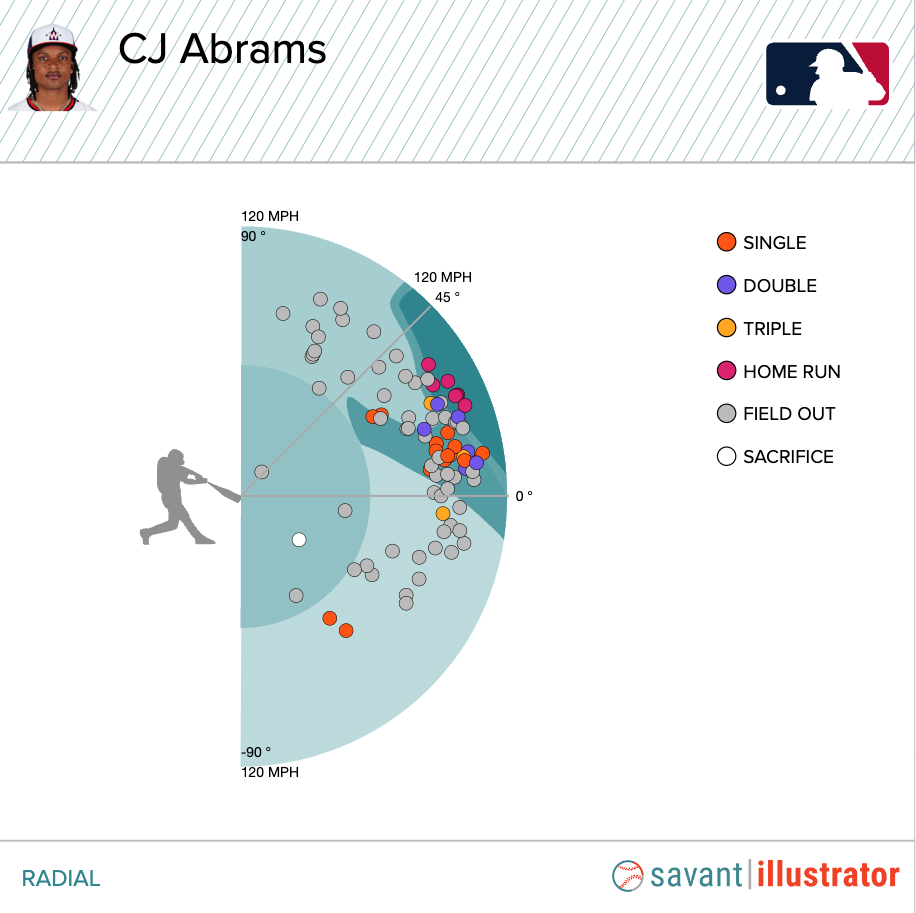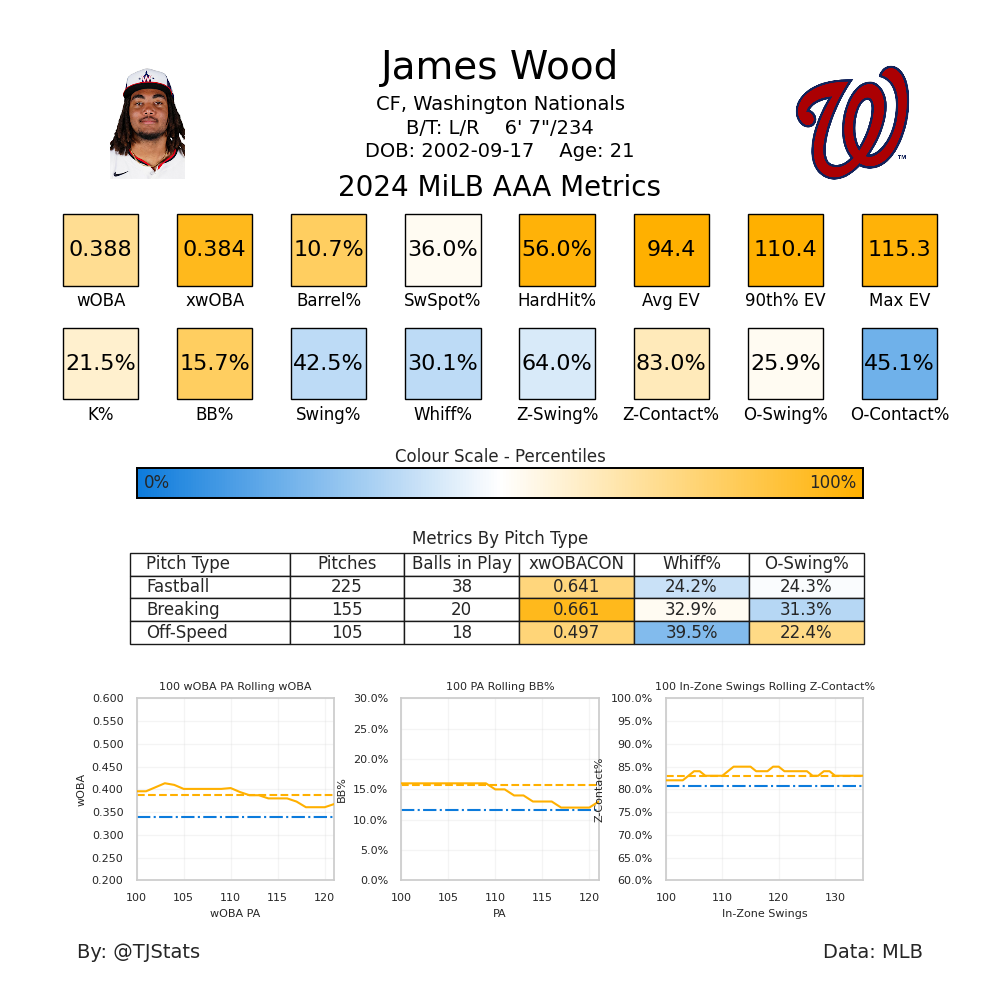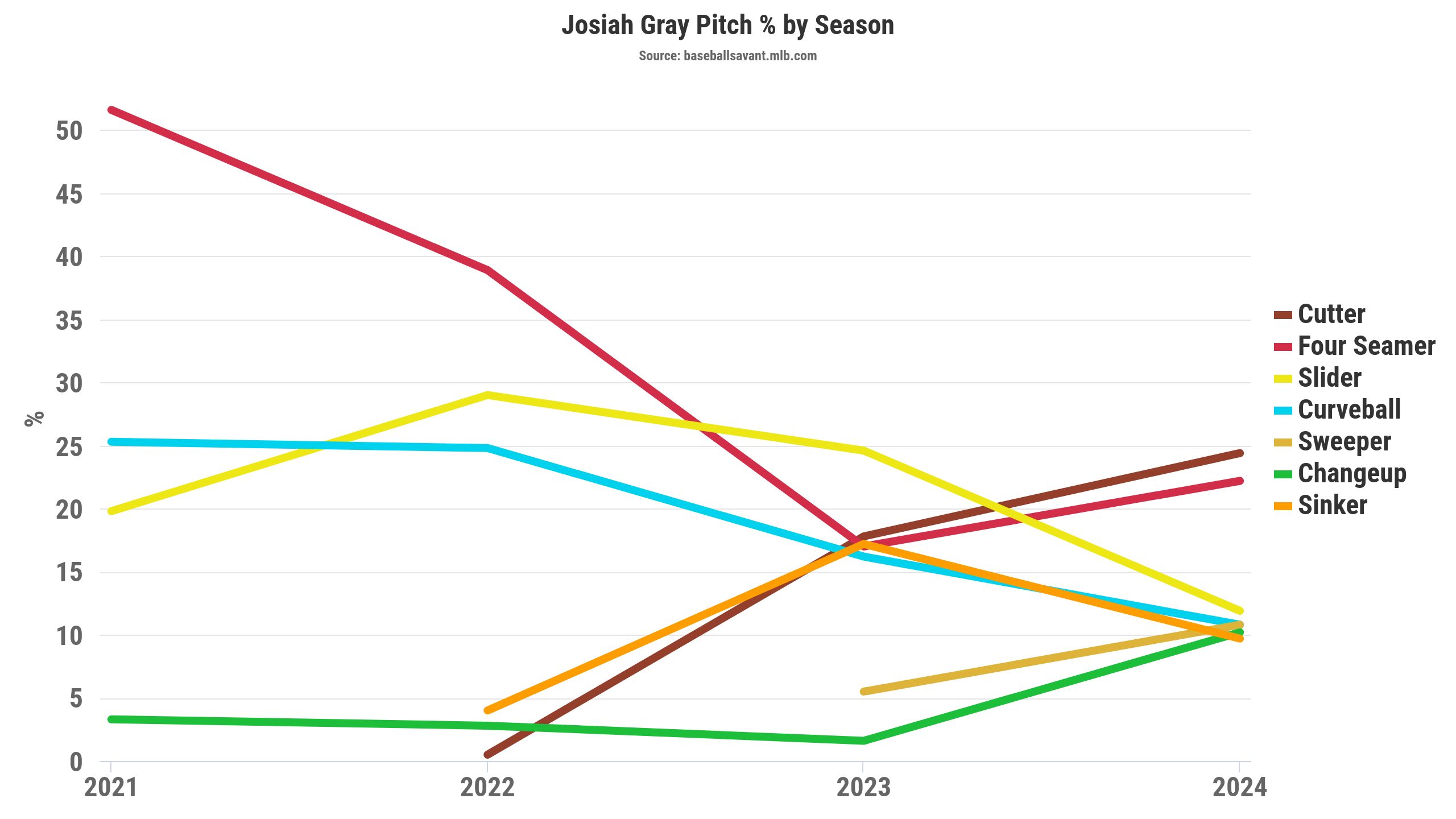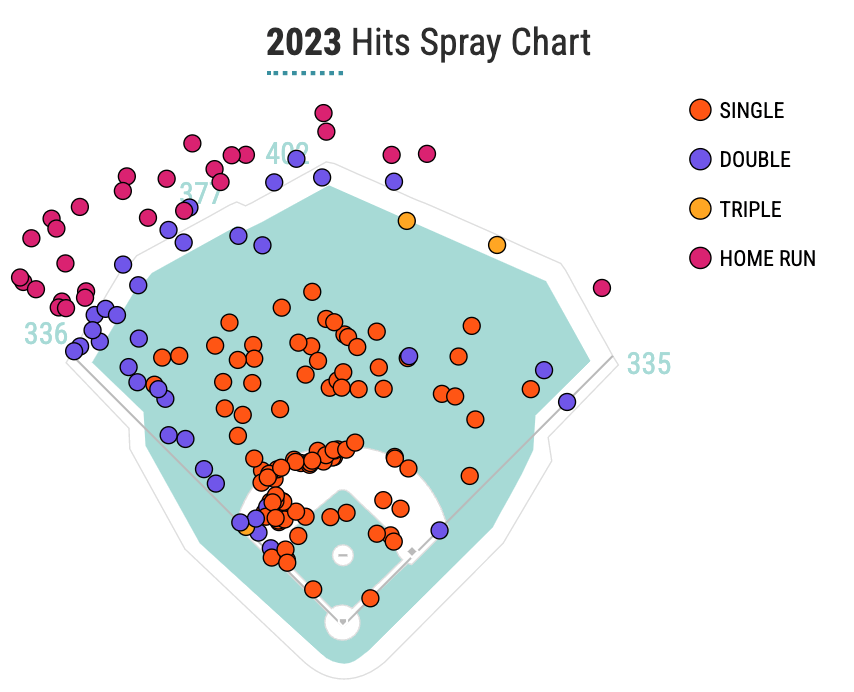I saw a Tweet the other day that I simply cannot get out of my head.
When can we start talking about how the Nats nailed the '21 & '22 deadlines https://t.co/pN8RMddGTd
— Liam Fennessy (@LiamFennessy_) April 29, 2024
The Nationals aren’t a good team. They have a zero-to-five percent chance of making the playoffs based on which projection system you trust most. They’ll probably win around 70 games.
But these Nationals are frisky.
They’re playing .500 ball 30 games into the year. They’ve won 11 of their 19 road games. They’ve taken sets against the Giants, Dodgers and Astros. They have a great bullpen and an equally good rotation. They’re not the worst offense in MLB (20th) or the worst defense (21st).
The 2019 title doesn’t seem long ago, not even five years. But it’s been a treacherous four-year stretch.
The Nats plunged into the cellar directly after winning it all. Anthony Rendon darted for L.A., Stephen Strasburg and Patrick Corbin reverted into pumpkins, and the Nationals finished the COVID-shortened season last place in the NL East at 26-34.
Things got worse, as they won only 37% of games over the next two seasons, including 107 losses in 2022. When the dust settled, the Nationals became the first team to finish last place in their division in four straight seasons without firing their manager or GM.
But I want to watch the Nationals for the first time in a few summers. Young stars are littered across the high-minor and major-league rosters because they’ve found tremendous talent at the past few deadlines. They’ve also made savvy free-agent signings but not splashy, ensuring that most resources go toward accruing more prospects. And they’ve begun to rebuild the farm system, which bottomed out in 2021.
Last year, Washington’s efforts started to bear fruits. Their 71 wins represented a 16-win improvement over 2022, and they scrapped together a 23-11 stretch in the second half.
And their young stars are shining quite bright in early 2024.
All that said, I want to check in on the state of Washington’s rebuild through the lens of their off-the-field roster moves over the past five years.
2022: Trading a Superstar
There’s no need to rehash the circumstances that led to the Nationals trading Juan Soto, and we don’t have to dive too deep into the superstar’s superstar 2024 start.
But the returns are worth talking about.
To spark your memory, here’s how the Washington-San Diego Soto deal panned out:
Padres receive:
Nationals receive:
It’s funny that neither Soto nor Bell is on the Padres roster anymore (stand up AJ Preller!). On the Nationals side, Luke Voit now plays in Mexico.
However, the Nationals may have struck gold with this deal, mainly thanks to Abrams and Gore’s breakout campaigns.
Let’s start with Abrams.
The youngster had a swing-decision problem in 2023. He chased everything for almost three months, peaking with a 27% strikeout rate in June. As a result, he was a bottom-of-the-barrel offensive player, posting an 85 wRC+ in the first half.
But Abrams started laying off fastballs in the zone and only swinging at balls he could drive. He cut his strikeout rate to a rock-solid 16% in the second half and became an average offensive player.

While he wasn’t an elite hitter, Abrams brought plenty of value on the basepaths. He swiped 35 bags across his final 36 stolen base attempts, second only to Ronald Acuña Jr. during the stretch.
Unfortunately, his stolen-base prowess has regressed in 2024, but only because he’s never on first base anymore. Abrams was always a young, dynamic player, but he’s unlocked a previously unimaginable power element.
Abrams posted 31 barrels on 450 batted balls last season (7%). This year, he has eight on 92 (9%). His sweet-spot rate has jumped 11 percentage points (33% to 44%), and his hard contact rate has jumped nine (29% to 38%).

He’s smacked seven homers, six doubles, and four triples in 28 games, nearly doubling his ISO year over year (.167 to .310). He’s slugging almost .600 in the early going, but his .548 expected slugging indicates it’s not entirely smoke and mirrors.
A common theme among young power breakouts is pulling fly balls. While he chased lousy fastballs last season, Abrams’ contact rate is up over three points from last season (77% to 80%), and he’s pulled over half of the fastballs he’s hit.
CJ Abrams has been on fire this season with 7 HR and 174 wRC+ through 25 GP in 115 PA
Abrams flashed some power in 2023 as he started to pull more fly balls in the 2nd half. He's pulling even more this season!
He has a 52.2 Pulled FB%, ranking 3rd in MLB (min. 40 FB+LD BBE) pic.twitter.com/sDiSur8ZC3
— Thomas Nestico (@TJStats) April 30, 2024
As a result, Abrams’ fastball production has soared:
He’ll likely see some negative regression, but he’s currently hitting like a top-five shortstop, ranking third among position players in wRC+ (162), trailing only Mookie Betts (239) and Elly De La Cruz (168).
Let’s touch on Gore.
Gore’s fastball has a 138 Stuff+ mark through 31 innings, second only to Jared Jones among MLB starting pitchers. He’s added two ticks of velo (97 mph) and an inch of ride (18” iVB) to the pitch.

And hitters are doing nothing but swinging under it:
Here are the top 10 highest ranking single-pitch tjStuff+ grades from the past week of the 2024 MLB Season. Only pitches which resulted in whiffs or called strikes are shown.
1) MacKenzie Gore vs Max Schuemann
4-Seam Fastball
151 tjStuff+ pic.twitter.com/gxClJAGyS8— Thomas Nestico (@TJStats) April 16, 2024
Gore has a 3.19 ERA through his first six starts, paired with a 3.51 expected ERA and a 2.69 FIP. His improved heater has boosted his strikeout numbers, as he’s nearing 30% after sitting at 24% across the prior two seasons.
His secondary pitches leave much to be desired, but he can deceive hitters with elite extension and, more importantly, has significantly improved his command and control. Gore’s Location+ mark has improved five points year over year (97 to 102), and he’s cut his walk rate in half from his rookie campaign (6% in 2024, 12% in 2022 with the Padres).
An elite fastball with well-located secondary offerings is a recipe for success, and Gore’s fastball improvement is leading to a breakout.
These two represent the crown jewel of the Soto trade – an Ace and an MVP candidate. It’s worth mentioning that while Soto has amassed 2.3 fWAR this season, Abrams and Gore have combined for 2.1.
If anything, Abrams is good enough to call the trade a win.
CJ Abrams is way too good to have been acquired in a trade with MacKenzie Gore and James Wood and Robert Hassell and Jarlin Susana. pic.twitter.com/ogHDoL1xww
— Grant Paulsen (@granthpaulsen) April 29, 2024
Among the minor league pieces in the Soto trade, Hassell has been plagued by injuries in his young career, while Susana is only 20. It’s too early to comment.
However, Wood is on the verge of the big league ballclub, and he’s on the brink of greatness.
The No. 7 overall prospect by Baseball Prospectus, Wood is a 6-foot-6, 240-pound monster lefty with elite barrel control, wild Statcast metrics, and sneaky speed.
James Wood had a day with 3 hits and 2 stolen bases today🔥 pic.twitter.com/D8NVNBoL8k
— The Call Up | An MLB Prospect Podcast (@The_CallUpPod) April 28, 2024
Through 26 games with Triple-A Rochester this season, Wood’s slashing .314/.422/.461 for an .882 OPS. While he’s only homered twice, his 94 mph average exit velocity is second among all Triple-A hitters this year, so more dingers will come, especially when he’s crushing all pitch types.
The best part about Wood is his power-discipline combination. He’s already walked 19 times in his 121 plate appearances (16%). He’s a little too free-swinging, but that’s somewhat characteristic of a big-boy power hitter.

These kids have talent. Even when Washington’s season likely ends on September 29 against the Phillies, the Nats will be worth watching in the meantime – this is not a lost season.
2021: The Less Impressive Superstar Deal
Alright, the Max Scherzer–Trea Turner deal didn’t pan out as well.
Let’s recap:
Dodgers receive:
Nationals receive:
- Keibert Ruiz
- Josiah Gray
- Gerardo Carillo
- Donovan Casey
Gray is a broken pitcher. He’s continually trying to reinvent himself, leaning into a cutter-sinker mix in favor of his lower-stuff four-seam.

But since the start of 2023, he’s been walking too many batters (11%) and allowing too many barrels (10%), adding up to an expected ERA well north of 5.00. Gray’s always had electric stuff, but he’s never been able to add up the sum of the parts. His curveball and slider don’t have enough movement, and he can’t locate anything.
Meanwhile, Ruiz has a contact-power problem at the plate, and the pitch clock has ruined his defensive abilities – he allowed 119 stolen bases last season, the most since Josh Bard in 2007. Even worse, he’s on an eight-year, $50 million contract.
Meanwhile, Carillo is playing in Mexico, and Casey is playing in the independent Atlantic League.
If this trade had panned out, the Nationals rebuild might be further along. But I guess not every move can be a home run.
The 2021 deadline move overshadowed by the dual-superstar deal is the Lane Thomas trade, where the Nationals dealt an aging Jon Lester to the Cardinals for the young, steady center fielder.
Thomas will never re-create his monster 24-game rookie campaign for the Cardinals (182 wRC+ in 2019), but he’s proven worthy of a mid-lineup spot. Last year, Thomas cashed in a 109 wRC+ by pulling over half his batted balls en route to a 28-homer season. Thomas started making more aggressive swing decisions and hunting fastballs early in the count, ultimately hitting seven first-pitch dingers.


Unfortunately, Thomas is dinged on the IL, which probably caused his early-season slump (.184/.250/.253 across his first 22 games). We’ll see what he brings to the table upon his return, but at the minimum, he’s a tremendous platoon bat (career 138 wRC+ against southpaws).
2019 & 2022: Bullpen Grabs
The best part about watching the Nationals is watching their bullpen.
Specifically, it’s watching Kyle Finnegan and Hunter Harvey.
Finnegan was signed from Oakland after the 2019 title. He’s made a whopping 240 relief appearances for the Nationals over the past five seasons, recently hitting the 60-save mark.
Sure, his statistical profile is mostly luck. Finnegan’s 2.03 ERA is backed up with an expected ERA nearing five, mainly because his batted-ball profile is a mess (90 mph avg. EV, 30th percentile; 10% barrel rate, 20th percentile).
Still, Finnegan’s fastball checks in around 97 mph with slightly above-average carry and elite arm-side break.

Combined with his recently added splitter – which boasts a 132 Stuff+ mark – Finnegan’s inducing a swinging-strike rate close to 15%. His command could be better, as his Location+ metric is down eight points from last season (109 to 101), and he’s walking 12% of batters. But nobody has more saves this season than his 10.
Kyle Finnegan, K'ing the Side (and a game-ending Expelliarmus Splitter). pic.twitter.com/6tct2BfzBY
— Rob Friedman (@PitchingNinja) May 2, 2024
Harvey is a much more fun case study.
Like Finnegan, Harvey is a fastball-splitter reliever.
However, Harvey’s fastball checks in closer to 98 mph with some extra ride, and he paints it – his 111 fastball Location+ mark ranks 28th among relievers with 10 innings pitched this year.
Hunter Harvey has an ELECTRIC ⚡ four-seam fastball
68.6% Useage 👀
42.1 K%
10.5 BB%.183 xBA 🆒️
.301 xSLG 🆗️
.250 xwOBA 👏👏👏98.3 Avg Pitch Velo 🔥🔥🔥
Someone help Christian Vasquez on this AB 🆚️ Mr Harvey's 4SFB#RotoBaller pic.twitter.com/sr3ArnnPr1
— RotoBaller MLB (@RotoBallerMLB) April 19, 2020
Meanwhile, Harvey’s splitter misses barrels as well as anyone, with a 21% swinging-strike rate and an expected wOBA of .250.
Harvey strikes out 32% of batters and walks 6% thanks to tough stuff and elite command, producing a ridiculous 1.26 FIP. Add his elite batted-ball profile, and Harvey has a 2.39 expected ERA.
I'm such a big Hunter Harvey guy pic.twitter.com/CDEaVNR36O
— Tanner McGrath (@tannerstruth) May 3, 2024
I’m not as bullish on the rest of the bullpen, which severely lacks depth. But combine the Finnegan-Harvey one-two punch with recent free-agent grabs Derek Law (2.84 ERA in 19 innings) and Dylan Floro (0.61 ERA in 15 innings), and the Nationals rank third in relief pitching fWAR this year (4.8).
Finnegan and Harvey won the Nationals many close games last season (28-21 in one-run games), and the 2024 Nationals bullpen is a sneaky fabulous unit.
Other Free Agent Grabs
One of the things Mike Rizzo has focused on during this rebuild is a splashy, short-contract approach to free agency.
For example, signing guys like Joey Gallo, Nick Senzel, and Eddie Rosario to one-year deals. These guys fill out rosters and provide modest at-bats.
But not attacking big-time free agents leaves the door open for the youths. Washington’s rebuild has centered around a relatively aggressive style of acquiring and playing prospects, allowing them to test the MLB waters and prove their strengths and weaknesses in real time.
While it’s led to Gray’s implosion and Ruiz’s collapse, it’s also led to Abrams’ power breakout, Gore’s new top-notch fastball, Thomas’ deep left-field fly balls, and a group of up-and-comers attempting to hang with MLB’s elite — and not doing a terrible job.
This is why the 2024 Nationals are fun to watch, even as they continue putting Corbin to the mound every five days. Most rebuilding squad fans closely monitor prospect improvements, but watching Abrams take his opportunity and evolve into an MVP Candidate overnight is a story all baseball fans should enjoy.
I don’t know if the Nationals will build a contention window in the coming seasons, but I think they’re close. At the minimum, they’re worth watching.
Photos by Icon Sportswire | Adapted by Aaron Polcare (@bearydoesgfx on X)

US Dollar 2,000 in a Single Online Day Due to its position, the United States offers a plethora of opportunities for those seeking employment. With so many options accessible, it might be difficult to know where to start. You may choose the ideal online housekeeping strategy with the tr-03 help of this post.
Begin here>>>>>>>>>>>>>> 4ty.me/rebjrd
no dylan crews???
Wow! You’re absolutely right. A total oversight by me. This article might need a second version at some point haha.